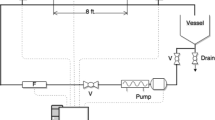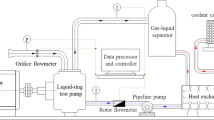Abstract
The drag-reducing properties of polysaccharides from marine microalgae were investigated. They were compared to two drag-reducing additives studied extensively in the past, synthetic poly(ethylene) oxide, one of the most effective drag-reducing additives; and Xanthan Gum, another biopolymer often considered a model polymer for chemical and rheological research. Compared to Xanthan Gum, the most effective polymers from our microalgae show a higher drag-reducing efficiency in terms of necessary concentration to achieve a given level of drag reduction. In addition, they show a striking Type-B drag reduction behavior, which may be a very useful quality in most drag reduction applications, thanks to the independence of the drag reduction level on flow conditions such as velocity, shear stress, and tube diameter. With these polymers from microalgae we did not see evidence of Type-A behavior over the wide range of conditions studied (including pipe diameters up to 52 mm). Importantly, this suggests that the Drag Reduction coefficient in pipe flow for ideal drag-reducing solutions such as the polysaccharides investigated here is invariant at a given additive concentration of flow or solution parameters like ionic strength and can be used as a solution property to predict its drag reduction effectiveness over a wide range of conditions. On the contrary, Xanthan Gum showed evidence of both Type-A behavior in large diameter pipes and Type-B behavior in smaller ones. The polymers from microalgae also showed high resistance to degradation. Considering that these microalgae are very effective producers of polysaccharides (both extracellular and intracellular), they appear to be very promising additives for drag reduction applications.











Similar content being viewed by others
References
Abdulbari HA, Letchmanan K, Yunus RM (2011) Drag reduction characteristics using aloe Vera natural mucilage: an experimental Study. J Appl Sci 11(6):1039–1043
Abdulbari HA, Kamarulizam NS, Nour AH (2012a) Grafted natural polymer as new drag reducing agent: an experimental approach. Chem Ind Chem Eng Q 18(3): 361–371.
Abdulbari HA, Yunus RM, Norahzan NA (2012b) A new natural drag reducing agent. CHUSER 2012 conference, December 3–4, Malaysia
Abdulbari HA, Shabirin A, Abdurrahman HN (2014) Bio-polymers for improving liquid flow in pipelines—a review and future work opportunities. J Ind Eng Chem 20:1157–1170
Aguilar G, Gasljevic K, Matthys EF (2001) Asymptotes of maximum friction and heat transfer reductions for drag-reducing surfactant solutions. Int J Heat Mass Transf 44(15):2835–2843
Benzi R, De Angelis E, L’Vov VS, Procaccia I, Tiberkevich V (2006) Maximum drag reduction asymptotes and the cross-over to the Newtonian plug. J Fluid Mech 551:185–195
Bewersdorff HW, Singh RP (1988) Rheological and drag reduction properties of Xanthan gum solutions. Rheol Acta 27(6):617–627
Choi HJ, Chan CK (2006) DNA-induced turbulent drag reduction and their molecular characteristics. The second international conference on flow dynamics, Sendai, Japan, November 16–18; AIP conference proceeding 832: 364–367
Choi HJ, Kim CA, Sohn J, Jhon MS (2000) An exponential decay function for polymer degradation in turbulent drag reduction. Polym Degrad Stab 69:341–346
Elbing BR, Winkel ES, Solomon MJ, Ceccio SL (2009) Degradation of homogeneous polymer solutions in high shear turbulent pipe flows. Exp Fluids 47:1033–1044
Etashola E, Karpasas M, Arad (Malis) S, Gottlieb M (1998) Red microalga exopolysaccharides: 2. Study of rheology, morphology and thermal gelation of aqueous preparations. Acta Polym 49:549–556
Gasljevic K, Aguilar G, Matthys EF (1999) An improved diameter scaling correlation for turbulent flow of drag-reducing polymer solutions. J Non Newton Fluid Mech 84:131–148
Gasljevic K, Aguilar G, Matthys EF (2001) On two distinct types of drag-reducing fluids, diameter scaling and turbulent profiles. J Non Newton Fluid Mech 96:405–425
Gasljevic K, Hall K, Chapman D, Matthys EF (2005) Biotechnology-based drag reduction for naval applications: production of biopolymers from marine microalgae and scale-up for type-B reducers. Proceedings of the 2nd international symposium on seawater drag reduction, Busan, Korea, 23–26 May
Gasljevic K, Hall K, Chapman D, Matthys EF (2008) Drag-reducing polysaccharides from marine microalgae: species productivity and drag reduction effectiveness. J Appl Phycol 20:299–310
Gasljevic K, Hall K, Oakes S, Chapman DJ, Matthys EF (2009) Increased production of extracellular polysaccharide by porphyridium cruentum immobilized in foam sheets. Eng Life Sci 9(6):479–489
Geresh S, Arad S (1991) The extracellular polysaccharides of the red microalgaae: chemistry and rheology. Bioresour Technol 38:195–201
Geresh S, Adin I, Yarmolinsky E, Karpasas M (2002) Characterization of the extracellular polysaccharide of Porphyridium sp.: molecular weight determination and rheological properties. Carbohydr Polym 50:183–189
Graham MD (2014) Drag Reduction and the dynamics of turbulence in simple and complex fluids. Phys Fluids 26:101301
Hall K (2004) The Applicability of Marine Algal Biopolymers as Drag-Reducing Additives. M. Sc. Thesis, University of California, Santa Barbara
Hall K, Gasljevic K, Chapman D, Matthys EF (2004) Drag-reducing biopolymers from marine microalgae: type B and diameter scale-up effects. In: Proceedings of the XIVth international congress on rheology, Seoul, Korea, Aug. 22–27, 2004; paper 687
Hellebust JA, Craigie JS (1978) Handbook of phycological methods: physiological and biochemical methods. Cambridge University Press, Cambridge
Hong CH, Zhang K, Choi HJ, Yoon SM (2010) Mechanical degradation of polysaccharide guar gum under turbulent flow. J Ind Eng Chem 16:178–180
Hong CH, Choi HJ, Zhang K, Renou F, Grisel M (2015) Effect of salt on turbulent drag reduction of Xanthan gum. Carbohydr Polym 121(342):347
Hoyt JW (1970) High molecular weight algal substances in the sea. Mar Biol 7:93–99
Hoyt JW (1984) Drag-reducing properties of polysaccharide solutions. In Colwell RR, Pariser ER and Sinskey AJ (Eds) Biotechnology of marine polysaccharide solutions. Hemisphere Pub. Corp., Washington 195–209
Hoyt JW, Soli G (1965) Algal cultures: ability to reduce turbulent friction in flow. Science 149(3691):1509–1511
Kenis PR (1968) Drag reduction by bacterial metabolites. Nature 217:940–942
Kenis PR (1971) Turbulent flow friction reduction effectiveness and hydrodynamic degradation of polysaccharides and synthetic polymers. J Appl Polym Sci 15:607–618
Kim CA, Choi HJ, Kim CB, Jhon MS (1998) Drag reduction characteristics of polysaccharide Xanthan gum. Macromol Rapid Commun 19:419–422
Lapasin R, Pricl S (1995) Rheology of industrial polysaccharides: theory and application, Blackie Academic & Professional, London p 83
Levy J and Davis S (1967) Drag Measurements on a Thin Plate in Dilute Polymer Solutions. Int Shipbuild Prog 14(152):166–175.
Lim ST, Choi HJ, Biswal D, Singh RP (2004) Turbulent drag reduction characteristics of amylopectin and its Derivative. E-Polymers 066.
Matthys EF (1991) Heat transfer, drag reduction, and fluid characterization for turbulent flow of polymer solutions: recent results and research needs. J Non Newton Fluid Mech 38:313–342
Ollis M (1981) The scaling of drag-reducing turbulent pipe flow. PhD Dissertation, University of Bristol.
Paterson RW, Abernathy FH (1970) Turbulent flow drag reduction and degradation with polymer solutions. J Fluid Mech 43(4):689–710
Pereira AS, Pinho FT (2000) Turbulent characteristics of shear-thinning fluids in recirculating flows. Exp Fluids 28:266–278
Ramus J, Kenney BE (1989) Shear degradation as a probe of microalgal exopolymer structure and rheological properties. Biotechnol Bioeng 34:1203–1208
Ramus J, Kenney BE, Shaughnessy EJ (1989) Drag-reducing properties of microalgal exopolymers. Biotechnol Bioeng 33:550–557
Rochefort WE, Middleman S (1986) Effect of molecular conformation on Xanthan gum drag reduction. In: Rabin Y (Ed.) Proceedings of the Polymer-flow interactions conference. AIP Publishing, Melville, NY, 10–12 July 1985
Sohn JI, Kim CA, Choi HJ, Jhon MS (2001) Drag-reduction effectiveness of xanthan gum in a rotating disk apparatus. Carbohydr Polym 45:61–68
Stelter M, Brenn G, Yarin AL, Singh RP, Durst F (2002) Investigation of the elongational behavior of polymer solutions by means of an elongational rheometer. J Rheol 46:507–527
Tiong ANT, Kumar P, Saptoro A (2015) Reviews on drag reducing polymers. Korean J Chem Eng 32(8):1455–1476
Vanapalli SA, Islam MT, Solomon MJ (2005) Scission-induced bounds on maximum polymer drag reduction in turbulent flow. Phys Fluids 17(9):095108. doi:10.1063/1.2042489
Virk PS (1975a) Drag reduction by collapsed and extended polyelectrolytes. Nature 253:109–110 (January 10)
Virk PS (1975b) Drag reduction fundamentals. AIChE J 21(4):625–656
Virk PS, Wagger DL (1989) Aspects of mechanisms in type-B drag reduction. In Gyr A (ed) Structure of turbulence and drag reduction, IUTAM Symposium Zurich Switzerland. Springer, Berlin 201–213
Virk PS, Wagger DL (1998) The Effect of salinity on turbulent drag reduction by polyelectrolyte additives at high reynolds numbers. In: Addendum to the proceedings of the international symposium on seawater drag reduction, Newport, Rhode Island
Wang Y, Yu B, Zakin JL, Shi H (2011) Review on drag reduction and its heat transfer by additives. Adv Mech Eng 2011:478749. doi:10.1155/2011/478749
White CM, Mungal MG (2008) Mechanics and Prediction of turbulent drag reduction with polymer additives. Annu Rev Fluid Mech 40:235–256
Wyatt NB, Liberatore MW (2009) Rheology and viscosity scaling of the polyelectrolyte Xanthan gum. J Appl Polym Sci 114(6):4076–4084
Acknowledgements
We would like to acknowledge gratefully the U.S. Office of Naval Research (S. Beerman-Curtin and K. Cooper, Program Directors) for partial financial support of this work, and the Advanced Technology Institute (R. Self, K. Carpentier, and M. Kraft, Program Managers) for programmatic and administrative support.
Author information
Authors and Affiliations
Corresponding author
Electronic supplementary material
Below is the link to the electronic supplementary material.
Rights and permissions
About this article
Cite this article
Gasljevic, K., Hall, K., Chapman, D. et al. Invariant Type-B characteristics of drag-reducing microalgal biopolymer solutions. Exp Fluids 58, 54 (2017). https://doi.org/10.1007/s00348-017-2338-6
Received:
Revised:
Accepted:
Published:
DOI: https://doi.org/10.1007/s00348-017-2338-6




